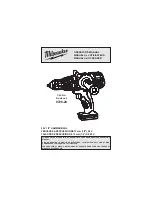
6
English
For keyless chuck (Fig. 2)
(1) Open the chuck jaws, and insert the bit into the
chuck.
To open the chuck jaws, hold the ring while turning
the sleeve in the counterclockwise direction (viewed
from the front side).
(2) Firmly grasp the ring and turn the sleeve in the
clockwise direction. Tighten securely.
(3) To remove the bit, firmly grasp the ring and turn the
sleeve in the counterclockwise direction.
(4) When the sleeve does not become loose any further,
fix the side handle to retaining ring, hold side handle
firmly, then turn the sleeve to loosen by hand. (
Fig. 3
)
6. Check the rotational direction (Fig. 4) (DV13VSS,
DV16VSS only)
The bit rotates clockwise (viewed from the rear side)
by turning the rotational change lever to R-mark.
The rotational change lever is returned to the L-mark
to turn the bit counterclockwise.
(The
L
and
R
marks are provided on the body.)
CAUTION
Always use the impact drill with clockwise rotation,
when using it as an impact drill.
7. Fixing the side handle (Fig. 5)
Attach the side handle to the mounting part.
Rotate the side handle grip in a clockwise direction
to secure it.
Set the side handle to a position that is suited to the
operation and then securely tighten the side handle
grip.
To attach a depth gauge on the side handle, insert
the gauge into the U-shaped groove on the side
handle, adjust the position of the depth gauge in
accordance with the desired depth of the hole, and
firmly tighten the side handle grip. (
Fig. 6
)
8. IMPACT to ROTATION changeover (Fig. 7)
Shift the change lever between the right and left
positions to switch easily between IMPACT (rotation
and impact) and ROTATION (rotation only),
respectively.
To bore holes in hard materials such as concrete,
stone and tiles, shift the change lever to the right-
hand position (as indicated by the
mark).
The drill bit operates by the combined actions of
impact and rotation.
To bore holes in metal, wood and plastic, shift the
change lever to the left-hand position (as indicated
by the
mark). The drill bit operates by rotational
action only, as in the case of a conventional electric
drill.
CAUTION
䡬
Do not use the Impact Drill in the IMPACT function
if the material can be bored by rotation only.
Such action will not only reduce drill efficiency,
but may also damage the drill tip.
䡬
Operating the Impact Drill with the change lever
in mid-position may result in damage. When
switching, make sure that you shift the change
lever to the correct position.
HOW TO USE
1. Switch operation (Fig. 8)
䡬
When the trigger is depressed, the tool rotates. When
the trigger is released, the tool stops.
䡬
Pulling the trigger and pushing the stopper, it keeps
the switched-on condition which is convenient for
continuous running. When switching off, the stopper
can be disconnected by pulling the trigger again.
<DV13VSS, DV16VSS only>
䡬
The rotational speed of the drill can be controlled by
varying the amount that the trigger switch is pulled.
Speed is low when the trigger switch is pulled slightly
and increases as the trigger switch is pulled more.
2. When using as a Drill or an Impact Drill
(1) Pressing force of the drill
You cannot drill holes more quickly even if you press
the drill with a stronger force than necessary. It not
only damages tip of drill bit and decreases the
efficiency of operation, but also shortens the life of
the drill tip.
(2) In case of penetrating holes
Drill bits can be broken when the material being
drilled is penetrated. It is important to decrease
pressing force just before penetrating.
CAUTION
In continuous operation, conduct no-load operation
for five seconds after completing a drilling job.
(3) When a thick drill bit is used
Your arm is subjected to larger reaction force when a
thicker drill bit is used. Be careful not to be moved by
the reaction force. For this, establish a foothold, hold
the unit tightly with both hands perpendicularly to
the material being drilled.
MAINTENANCE AND INSPECTION
1. Inspecting the drill bits
Since use of an abraded drill bits will cause motor
malfunctioning and degraded efficiency, replace the
drill bits with a new one or resharpening without
delay when abrasion is noted.
2. Inspecting the mounting screws
Regularly inspect all mounting screws and ensure
that they are properly tightened. Should any of the
screws be loose, retighten them immediately. Failure
to do so could result in serious hazard.
3. Maintenance of the motor
The motor unit winding is the very “heart” of the power
tool. Exercise due care to ensure the winding does not
become damaged and/or wet with oil or water.
4. Inspecting the carbon brushes
For your continued safety and electrical shock
protection, carbon brush inspection and replacement
on this tool should ONLY be performed by a HITACHI
AUTHORIZED SERVICE CENTER.
5. Replacing supply cord
If the replacement of the supply cord is necessary,
this has to be done by Hitachi Authorized Service
Center in order to avoid a safety hazard.
6. Service parts list
A: Item No.
B: Code No.
C: No. Used
D: Remarks
01Eng_DV13SS_WE
4/23/12, 4:24 PM
6








































